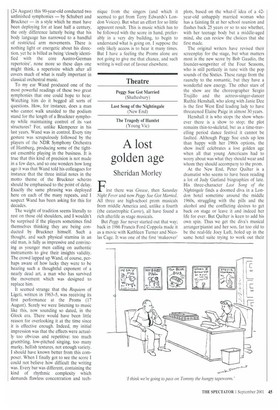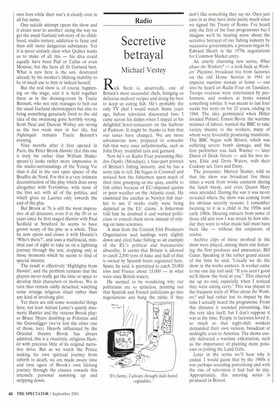Peggy Sue Got Married (Shaftesbury) Last Song of the Nightingale (New End) The Tragedy of Hamlet (Young Vic)
A lost golden age
Sheridan Morley
First there was Grease, then Saturday Night Fever and now Peggy Sue Got Married, All three are high-school prom musicals from middle America and, unlike a fourth (the catastrophic Carrie), all have found a rich afterlife as stage musicals.
But Peggy Sue never started out that way; back in 1986 Francis Ford Coppola made it as a movie with Kathleen Turner and Nicolas Cage. It was one of the first 'makeover' plots, based on the what-if idea of a 42year-old unhappily married woman who has a fainting fit at her school reunion and flashes back 25 years or so to see whether, with her teenage body but a middle-aged mind, she can review the choices that she first made.
The original writers have revised their screenplay for the stage, but what matters most is the new score by Bob Gaudio, the founder-songwriter of the Four Seasons, who is still perfectly in tune with the pop sounds of the Sixties. These range from the raunchy to the romantic, but they have a wonderful new energy. The other stars of the show are the choreographer Sergio Trujillo and the actress-singer-dancer Ruthie Henshall, who along with Janie Dee is the first West End leading lady to have threatened Elaine Paige in almost 30 years.
Henshall it is who stops the show whenever there is a show to stop; the plot remains thin-to-skeletal, but as a time-travelling period dance festival it cannot be faulted. Although Peggy Sue ends up less than happy with her 1960s options, the show itself celebrates a lost golden age when all that young Americans had to worry about was what they should wear and whom they should accompany to the prom.
At the New End, Peter Quilter is a dramatist who seems to have been reading a lot of Judy Garland biographies of late. His three-character Last Song of the Nightingale finds a doomed diva in a London hotel sometime around the middle 1960s, struggling with the pills and the alcohol and the conflicting desires to get back on stage or leave it and indeed her life for ever. But Quilter is keen to add his own spin. Thus we get the diva's musical arranger/pianist and her son, far too old to be the real-life Joey Luft, holed up in the same hotel suite trying to work out their own lives while their star's is clearly over in all but name.
One suicide attempt opens the show and it closes near to another: along the way we get the usual Garland sob-story of no childhood, studio torture, addiction to fame and then still more dangerous substances. Yet it is never entirely clear what Quilter wants us to make of all this — his diva could equally have been Piaf or Callas or even Monroe, but the facts all fit Garland best. What is new here is the son, destroyed already by his mother's lifelong inability to be of much use to him or indeed herself.
But the real show is, of course, happening on the stage, and it is held together there as in the dressing-room by Tracie Bennett, who not only manages to belt out the usual Garland showstoppers but also to bring something genuinely fresh to the old idea of the swansong gone horribly wrong. Scott Neal and Duncan Wisbey are strong as the two weak men in her life, but Nightingale remains Tracie Bennett's evening.
Nine months after it first opened in Paris, the Peter Brook Hamlet (for this one is truly his rather than William Shakespeare's) looks rather more impressive in the studio-surroundings of the Young Vic than it did in the vast open spaces of the Bouffes du Nord. For this is a very intimate deconstruction of the play which does away altogether with Fortinbras, with most of the first act, with all of the politics, and which gives us Laertes only towards the end of the play.
But Brook at 76 is still the most impressive of all directors, even if in the 50 or so years since he first staged Hamlet with Paul Scofield at Stratford he seems to have grown weary of the play as a whole, Thus he now opens and closes it with Horatio's 'Who's there?', and uses a multiracial, minimal cast of eight to take us on a lightning journey through the text, stopping only at those moments which he seems to find of special interest.
The result is effectively 'Highlights from Hamlet', and the problem remains that the players never really get the time or space to develop their characters or motives. We in turn thus remain oddly detached, watching some strange religious ritual rather than any kind of involving plot.
Yet there are still some wonderful things here, not least Adrian Lester's quietly mesmeric Hamlet and the veteran Brook player Bruce Myers doubling as Polonius and the Gravedigger (we've lost the other one of those, too). Heavily influenced by the Oriental theatre Brook has always admired, this is a ritualistic, religious Hamlet with precious little of its original narrative drive. But as we watch the Prince making his own spiritual journey from rebirth to death, we are made aware time and time again of Brook's own lifelong journey through the classics towards this intensely personal summing up and stripping down.



























































 Previous page
Previous page